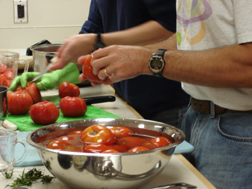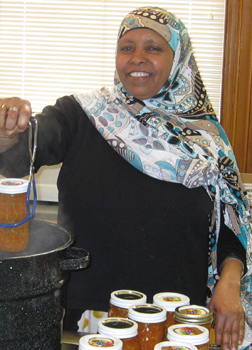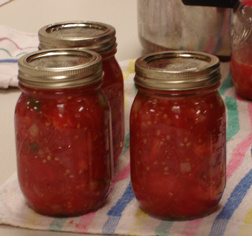Preserving the Harvest FAQ
 Whether you have a few pots of tomatoes and greens on your porch, grow a garden full of vegetables and fruits, or buy fresh produce from your local farmers market, you won’t want to let it go to waste.
Whether you have a few pots of tomatoes and greens on your porch, grow a garden full of vegetables and fruits, or buy fresh produce from your local farmers market, you won’t want to let it go to waste.
How canning preserves food
Fresh foods spoil for a variety of reasons. Bacteria, molds, and yeasts cause damage, and so do food enzymes and contact with air. Microorganisms live and multiply quickly on the surfaces of fresh food and inside bruised, insect-damaged, and diseased food.
Canning preserves food by using heat to destroy the microorganisms that cause spoilage. Heat forces air out of the jar. As the jar cools, a seal (vacuum) forms. Proper canning techniques will stop the growth and activity of microorganisms and can prevent spoilage and quality loss.
Use these techniques to get safe food and high-quality results:
- Select fresh food and wash it well.
- Prepare foods according to our recommendations, or those published by the National Center for Home Food Preservation. You may need to peel and cut some fresh foods, add acid (bottled lemon juice, citric acid, or vinegar), or use a hot pack. See our Let’s Preserve series for more information.
- Use recommended jars and two-piece self-sealing lids.
- Process jars in a boiling-water bath, atmospheric steam canner, or pressure canner according to instructions for the correct period of time.
Ensure safe canned foods
The processing times and temperatures noted in University of Maine Cooperative Extension publications have been set using scientific research. For safe, high-quality home-canned food, follow these directions carefully.
Pressure canning is the only canning method recommended for low-acid foods like meat, poultry, seafood, and vegetables. Clostridium botulinum, the bacterium that causes botulism food poisoning, is destroyed in low-acid foods when they are processed at the correct time and temperature in pressure canners.
Canning low-acid foods in boiling-water bath canners is ABSOLUTELY unsafe because the botulism bacteria spores can survive this process.
If Clostridium botulinum bacteria survive and grow inside a sealed jar of food, they can produce a deadly toxin. Even a taste of food containing this toxin can be fatal.
Boiling food for 10 to 15 minutes before eating it is a way to inactivate the toxin if present. But using acceptable canning recommendations is the only way to be sure home-canned food does not have botulism toxin.
 Avoid unsafe equipment and canning methods
Avoid unsafe equipment and canning methods
- Never open-kettle can or process jars of food in conventional ovens, microwave ovens, or dishwashers. These practices do not prevent spoilage.
- According to the National Center for Home Food Preservation, “sufficient studies and peer review have been completed that we are now able to say that as long as certain critical controls at various steps in the canning process are achieved, USDA and NCHFP process times for canning acid or properly acidified foods (pH of 4.6 or below) at home with properly research-based recipes and procedures can be used. For more information on steam canning, visit Using Steam Canners.
- So-called “canning powders” are useless as preservatives and do not replace the need for proper heat processing.
- Jars with wire bails and glass caps make attractive storage containers for dry foods, but don’t use them for canning. One-piece zinc, porcelain-lined caps are also no longer recommended. They do not form a proper seal.
Food acidity determines canner type
Whether you should process food in a pressure canner or boiling-water canner to control botulinum bacteria depends on the amount of acid in the food. The term “pH” is a measure of acidity. The lower the pH, the more acidic the food.
Acid foods include pickles, most fruits, and jams and jellies made from fruit. (In pickling, the acid level is increased by adding bottled lemon juice, citric acid or vinegar.) Acid foods contain enough acidity to either stop the growth of botulinum bacteria or destroy the bacteria more rapidly when heated.
Low-acid foods don’t contain enough acid to prevent the growth of botulinum bacteria. Process these foods at temperatures of 240 to 250°F. These high temperatures are attainable only with pressure canners operated at 10 to 15 PSI.1 The exact time depends on the kind of food being canned, the way it is packed into jars, and the size of the jars.
Low-acid foods include red meats, seafood, poultry, milk, all fresh vegetables, and some tomatoes. When you mix low-acid and acid foods, assume the mixture is low acid.
Although tomatoes used to be considered an acid food, some are now known to have pH values slightly above 4.6, which means they are low acid. To safely can them as acid foods in a boiling-water canner, you must add bottled lemon juice or citric acid. For specific instructions on canning tomatoes, see bulletin #4085, Let’s Preserve Tomatoes.
Use the right jars and lids
Regular and wide-mouth, Mason-type, threaded jars with two-piece, self-sealing lids are the best choice for home canning. They are available in 4 ounce, 8 ounce, 12 ounce, pint, quart, and half-gallon sizes. The regular jar mouth opening is about 2-3/8 inches. Wide-mouth jars have openings of about three inches, which makes them easier to fill and empty. Use half-gallon jars only for canning acidic (fruit) juices using a tested recipe.
With careful handling, Mason jars and screw bands may be reused many times. You will need to use new dome lids (flats) each time, they are not reusable. After jars have cooled, remove screw bands. Wash and dry bands and store in a dry area. If left on stored jars, they become hard to remove and often rust, which makes them unusable.
 Remember these good canning practices
Remember these good canning practices
- Process low-acid foods in a pressure canner with an accurate gauge. (See our pressure gauge testing service.)
- Make sure process times and pressures match the size of the jar, style of pack, and kind of food being canned.
- Be sure the jar lid is firmly sealed and is concave (curved down slightly in the center).
- Check that nothing has leaked from the jar.
- Check that no liquid spurts out when jar is opened.
- Check for unnatural or “off” odors.
- If you have questions or would like to talk to an expert, contact your local Cooperative Extension office. If you are interested in taking a hands-on food preservation workshop, see our upcoming classes.
1 Pounds per square inch of pressure
Excerpted and adapted from the Let’s Preserve series, University of Maine Cooperative Extension.
